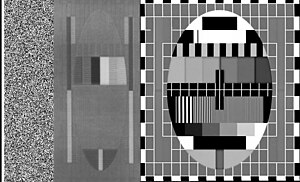A-MAC
This article provides insufficient context for those unfamiliar with the subject. (October 2009) |


A-MAC carries the digital information: sound, data-teletext on an FM subcarrier at 7 MHz. Since the vision bandwidth of a standard MAC signal is 8.4 MHz, the horizontal resolution on A-MAC has to be reduced to make room for the 7 MHz carrier. A-MAC has not been used in service.
Technical details
MAC transmits luminance and chrominance data separately in time rather than separately in frequency (as other analog television formats do, such as composite video).
Audio and Scrambling (selective access)
- Audio, in a format similar to NICAM was transmitted digitally rather than as an FM subcarrier.
- The MAC standard included a standard scrambling system, EuroCrypt, a precursor to the standard DVB-CSA encryption system.
TV transmission systems
- Analog high-definition television systems
- PAL, what MAC technology tried to replace
- SECAM, what MAC technology tried to replace
- A-MAC
- B-MAC
- C-MAC
- D-MAC
- E-MAC
- S-MAC
- D2-MAC
- HD-MAC, an early high-definition television standard allowing for 2048x1152 resolution.
- DVB-S, MAC technology was replaced by this standard
- DVB-T, MAC technology was replaced by this standard
External links
- Multiplexed Analogue Components in "Analog TV Broadcast Systems" by Paul Schlyter
